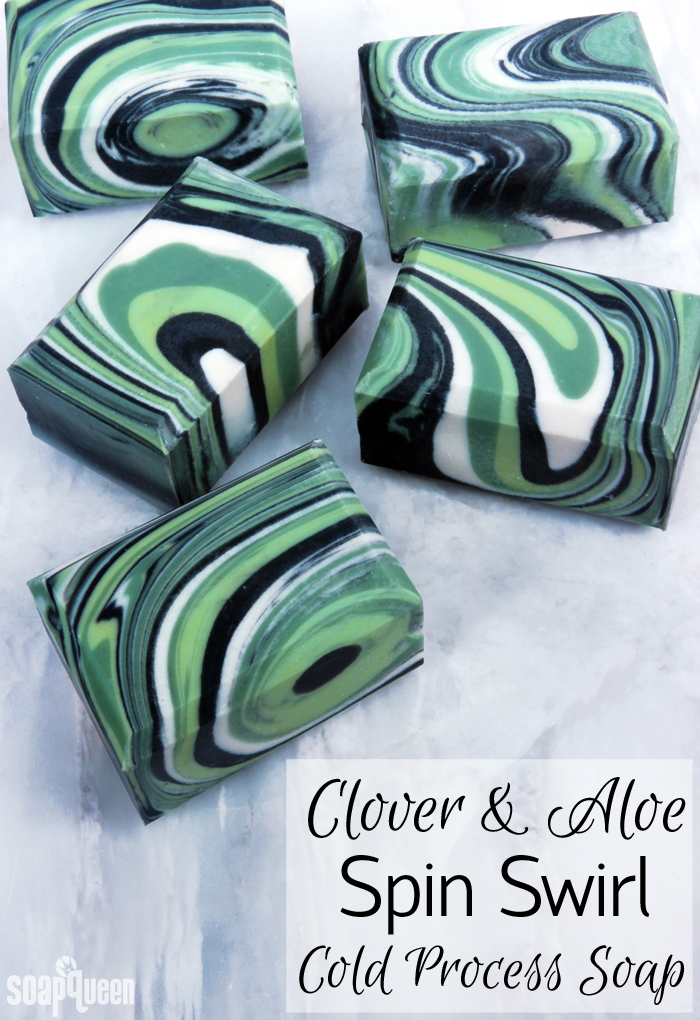
The spin swirl technique refers to pouring layers of soap into the mold, then spinning the soap to create a unique design. The key to the spin swirl is a slow-moving recipe and fragrance oil that does not accelerate trace. This Clover and Aloe Spin Swirl Soap is made with the new Clover and Aloe Fragrance Oil, which behaves wonderfully in cold process. I also like to use a lazy Susan for this project – it really helps with spinning motion!
If you’re a beginner soaper, I would recommend getting a few recipes under your belt before attempting this project. The soap batter must stay fluid for a long period of time, so a good understanding of trace is essential. If you’re looking for more spin swirl tutorials, check out the Psychedelic Spin Swirl Cold Process Soap and the Pantone Spin Swirl Cold Process Soap for more inspiration.
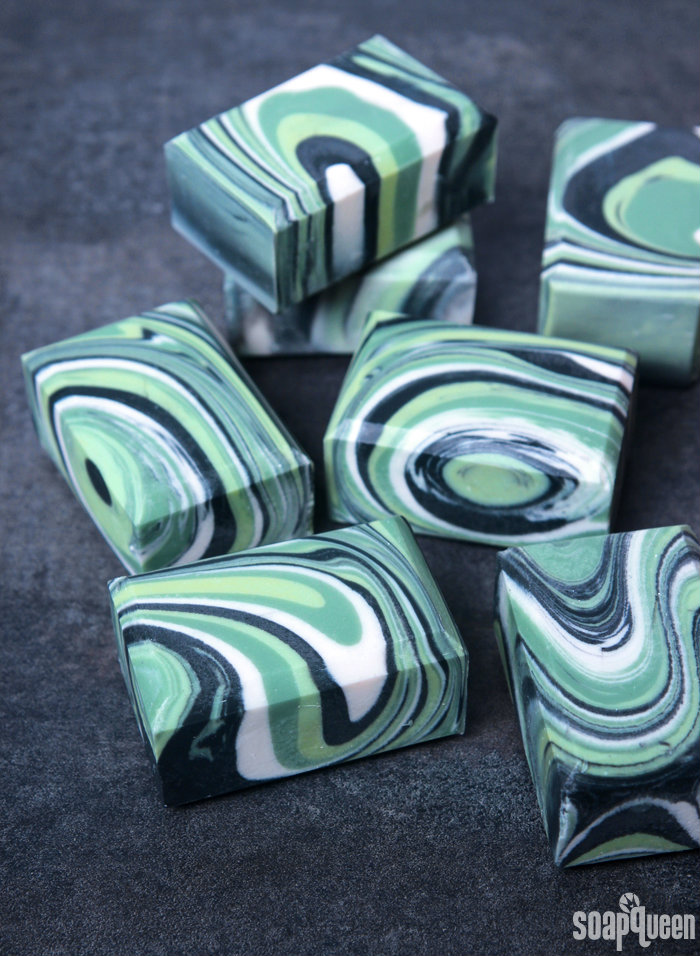
What You Need:
9 Bar Birchwood Mold + Dividers
Silicone Liner for 9 Bar Mold
16 oz. Canola Oil (40%)
0.8 oz. Castor Oil (2%)
8 oz. Coconut Oil (20%)
8 oz. Palm Oil (20%)
4 oz. Rice Bran Oil (10%)
3.2 oz. Sweet Almond Oil (8%)
5.5 oz. Sodium Hydroxide Lye
13.2 oz. Distilled Water
2.5 oz. Clover and Aloe Fragrance Oil
Titanium Dioxide
Kermit Green Mica
Evergreen Mica
Black Oxide
Optional: Sodium Lactate

Click here to add everything you need for this project to your Bramble Berry shopping cart!
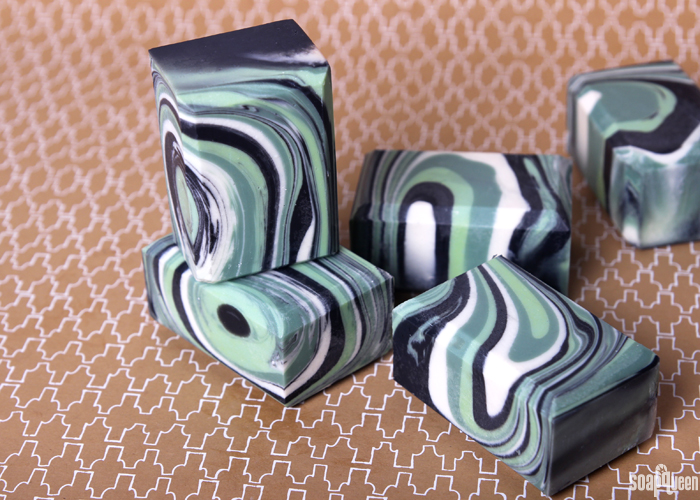
- 9 Bar Birchwood Mold + Dividers
- Silicone Liner for 9 Bar Mold
- 16 oz. Canola Oil (40%)
- 0.8 oz. Castor Oil (2%)
- 8 oz. Coconut Oil (20%)
- 8 oz. Palm Oil (20%)
- 4 oz. Rice Bran Oil (10%)
- 3.2 oz. Sweet Almond Oil (8%)
- 5.5 oz. Sodium Hydroxide Lye
- 13.2 oz. Distilled Water
- 2.5 oz. Clover and Aloe Fragrance Oil
- Titanium Dioxide
- Kermit Green Mica
- Evergreen Mica
- Black Oxide
- Optional: Sodium Lactate
- Slowly and carefully add the 5.5 ounces of lye to 13.2 ounces of water and gently stir until the lye has fully dissolved and the liquid is clear. Set aside to cool. If you’d like a harder bar of soap that releases faster from the mold, you can add sodium lactate to the cooled lye water. Use 1 teaspoon of sodium lactate per pound of oils in the recipe. For this recipe, you’d add 2.5 teaspoons.
- Melt and combine the 16 ounces of canola oil, 0.8 ounces of castor oil, 8 ounces of coconut oil, 8 ounces palm oil, 4 ounces of rice bran oil, 3.2 ounces of sweet almond oil and 8 ounces of palm oil (remember to fully melt then mix your entire container of palm oil before portioning). Once the lye water and the oils have cooled to 130 degrees or below (and are ideally within 10 degrees of each other), add the lye water to the oils and stick blend until a very thin trace.
- Be careful to not over emulsify the batter. The soap batter should be very thin. You can always stick blend more later. Split the batch into four containers. Each container will hold about 400 mL.
- To one container, add 1 tablespoon dispersed titanium dioxide. To another add 2 tablespoons of dispersed Kermit Green Mica and ½ teaspoon titanium dioxide. To the third container, add 2 teaspoons of Evergreen Mica. To the final container, add 1 teaspoon of dispersed black oxide. Use a whisk to mix in the colorants.
- Add the Clover and Aloe Fragrance Oil to each container evenly - it's okay to eyeball it.
- Now it’s time to pour. We like to place the mold on a Lazy Susan to help spin the soap. The order in which you pour the colors into the mold is up to you. We like to pour two contrasting colors into opposite corners of the mold at the same time. Continue to pour varying colors into the corners of the mold.
- Count to three during each pour to help pour an even amount. Pour color in the opposite corner of the mold, counting to three to help pour evenly. Start pouring various colors into both corners of the mold. As you layer the colors, the soap is pushed toward the center of the mold. Work as quickly as possible during this process, as the soap will continue to thicken up with time. Every now and then, give the colors a whisk to help keep them fluid. Jiggle the mold to loosen up the soap if it begins to mound up.
- Once all the colors have been poured into the mold spin the Lazy Susan, stopping it quickly to help give the soap movement. You want the centrifugal force created by the spin and stop movement to move the soap in various directions within the mold. Be careful not to spin too hard, or the soap may spill out of the mold.
- Continue swirling until you’re happy with the pattern. Be careful to not over-swirl the soap, or the colors will muddle together.
- Once you’re happy with the swirl, place the divider set into the mold until it reaches the bottom. Spray the top of the soap with 99% isopropyl alcohol to help avoid soda ash.
- Let the soap stay in the mold for about 4-5 days.
- Remove the silicone liner from the wood mold. Pull the silicone liner away from the soap to release the airlock. Push the entire slab of soap out. If it's still quite soft, allow it to sit upside down for 1-2 days to harden.
- Gently remove the soap from the dividers. To prevent tearing, do not pull the dividers. Push the soap down, or slide the dividers up or down to remove the soap without tearing. Allow the soap to cure for 4-6 weeks, and enjoy!
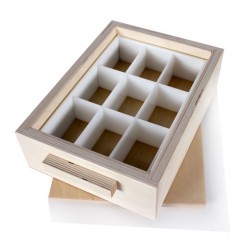
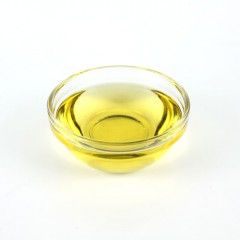
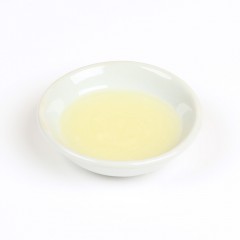
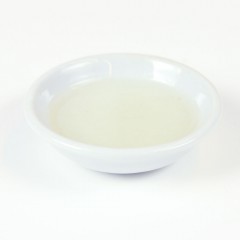
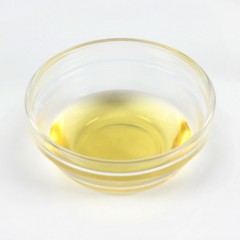
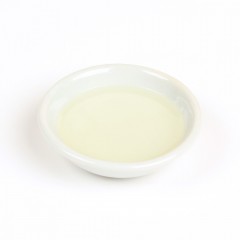
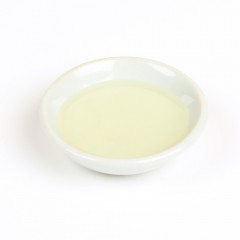
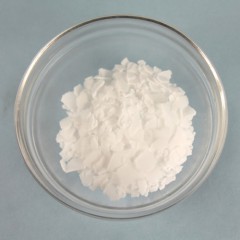
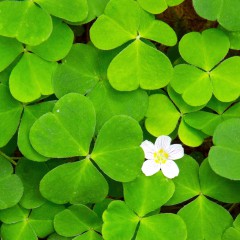
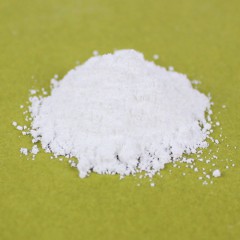
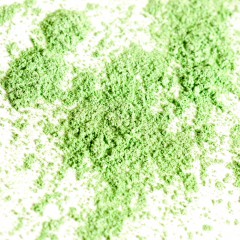
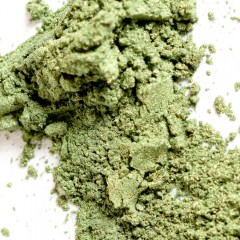
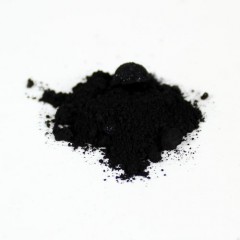
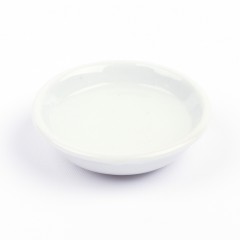
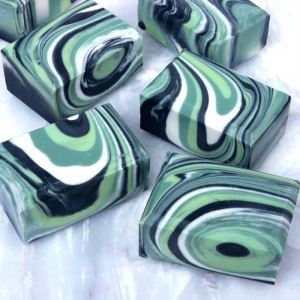


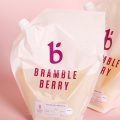
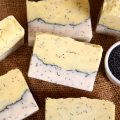
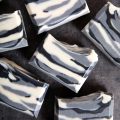
Is there a pdf format or text version of the instructions? I have all the materials and don’t want to have to screenshot the video or watch it over and over again
We’ll get this post updated with a printable recipe card.
Hey 🙂 I was wondering if there was an easy way to identify which frangrances will speed up trace?
The product descriptions on BrambleBerry.com have performance notes that say if the soap accelerates or discolors: https://www.brambleberry.com/Fragrance-Oils-C161.aspx
Those notes are also listed on the labels.
This list is a good resource as well, it includes fragrances that don’t accelerate: https://www.soapqueen.com/bath-and-body-tutorials/tips-and-tricks/complete-list-of-non-accelerating-fragrance-oils/
Can I use a heating pad with this recipe to encourage gel phase?
Yes, you can put the lid on this soap and place it on a heating pad set to medium for 20 minutes. Turn it off after then but leave it on the heating pad. If it’s pretty cold in your house, you can also cover the mold with a towel or blanket.
Learn more about insulating soap here: http://www.soapqueen.com/bath-and-body-tutorials/tips-and-tricks/when-to-insulate-handmade-soap/
And more about gel phase here: http://www.soapqueen.com/bath-and-body-tutorials/tips-and-tricks/gel-phase/
I made this recipe but used the following BrambleBerry colors: Titanium White, Kermit Green, Racing Stripe Orange, Lemonade and 2.9 oz Kumquat Fragrance. It reminds me of creamsicles. I’m one day in the 9 bar mold and it looks great!
That’s awesome, sounds like a lovely color and scent combination.
Kumquat Fragrance Oil: https://www.brambleberry.com/Kumquat-Fragrance-Oil-P3335.aspx
Kermit Green Mica: https://www.brambleberry.com/Kermit-Green-Mica-P6352.aspx
Racing Stripe Orange Mica: https://www.brambleberry.com/Racing-Stripe-Orange-Mica-P6457.aspx
Fizzy Lemonade Colorant: https://www.brambleberry.com/Fizzy-Lemonade-Colorant-P4965.aspx
I bought the Silicone Liner for 9 Bar Mold & 9 Bar Birchwood Mold + Dividers. My bars didn’t come out with the nice beveled edges pictured in the tutorial. Was I given the wrong mold?
Never mind. I see it’s done separately with a beveler and planer tool.
Yes, those tools give the bars a polished finishing touch. Find that tool here: https://www.brambleberry.com/Soap-Beveller-P4141.aspx
The Soap Shaver is nice too, you can use it to take off uneven edges or soda ash: https://www.brambleberry.com/Soap-Shaver-P6331.aspx
-Kelsey with Bramble Berry
Oh I didn’t want my real name on this comment but it auto did it. Is it okay if you delete these two comments please?
Hi, can you use the BB swirl quick mix for this? Thanks!
Yes, that will work nicely for this recipe. Just make sure to run it through the Lye Calculator to get the correct amounts: https://www.brambleberry.com/Pages/Lye-Calculator.aspx
-Kelsey with Bramble Berry
Swirl Quick Mix: https://www.brambleberry.com/Swirl-Recipe-Quick-Mix-P5526.aspx
Wow love watching you tutorials!!
I’m a newbie and this video answered lot of questions but I still have one. Did you discount water for this recipe? Because I have seen soap makers doing that when using titanium Dioxide. Or is just when using titanium Dioxide diluted in water? I’m so confused.
Thank you
This recipe is not water discounted. You can discount for a number of reasons – if your recipe contains titanium dioxide, if it has a puree with extra water, or if you just want it to harden faster. Learn more about water discounting here: http://www.soapqueen.com/bath-and-body-tutorials/tips-and-tricks/water-discounting-cold-process-soap-how-why/
Water discounting does accelerate trace though, which would affect this recipe. It needs a very slow trace to get the design.
-Kelsey with Bramble Berry
What can I substitute for the Castor oil? More Canola? Thank you!!
Castor oil is unique and there is no direct substitute for it. It’s a thick oil that adds lather to the bars. If you like, you can add more canola. Just keep in mind the bars won’t bubble as much. Also, make sure to run the recipe through the Lye Calculator after any substitutions!
Lye Calculator: https://www.brambleberry.com/Pages/Lye-Calculator.aspx
Learn more about substituting oils in cold process soap here: http://www.soapqueen.com/bath-and-body-tutorials/tips-and-tricks/how-to-substitute-oil-in-cold-process-recipes/
-Kelsey with Bramble Berry
Are there printable directions anywhere for this recipe? I try not to keep my laptop to close when I am soaping…I’m sure you can imagine why! I just bought the ingredients to make this soap and can’t wait to make it.
We don’t have printable instructions for this recipe. Sorry about that Jill. We do have printable instructions for another spin swirl design though! That uses the same technique and may be helpful for you: https://www.soapqueen.com/bath-and-body-tutorials/cold-process-soap/psychedelic-spin-swirl-cold-process-tutorial/
-Kelsey with Bramble Berry
Do you think the spin and swirl would work with the shampoo bar recipe?
Also, could I use activated charcoal for the black colorant and Zinc oxide for the white colorant?
Hi Kelsey!
Which shampoo bar recipe are you wanting to use? Also, you can use activated charcoal and zinc oxide. Both would work well in this recipe. You may need a bit more or less, so I would recommend prepping extra color mixed in oil just in case. 🙂
Activated charcoal: https://www.brambleberry.com/Activated-Charcoal-P4956.aspx
Zinc oxide: https://www.brambleberry.com/Zinc-Oxide-P5046.aspx
-Kelsey with Bramble Berry
Hi, a great many of these geocentric or spin recipes use canola oil. I get that it is thin and moves well in the thin designs and patterns, but I hate canola oil. Is there something other than sunflower oil that you think would work as a similar fluidity in the soaping? I have lots of nut oils, palm, coconut, tallow, olive, rice etc. I was wondering about rice bran oil as a sub? Thanks.
Hi Kirsten!
You can use any slow-moving liquid oil! Both olive oil and rice bran oil work nicely. Oils that are liquid at room temperature give you time to work with the design. In this recipe, you can replace the canola oil with olive oil. Just make sure to run the recipe through the Lye Calculator after any substitutions. 🙂
Lye Calculator: https://www.brambleberry.com/Pages/Lye-Calculator.aspx
This post has more information on oils that work well for swirling soap: https://www.soapqueen.com/bath-and-body-tutorials/tips-and-tricks/five-tips-swirling-cold-process-soap/
And this post has tips on substituting oils in cold process soap: http://www.soapqueen.com/bath-and-body-tutorials/tips-and-tricks/how-to-substitute-oil-in-cold-process-recipes/
-Kelsey with Bramble Berry
My spin swirl didn’t spin…..I don’t know what happened. I used the same exact recipe and used the fragrance Blueberry Jam which was wonderful to work with. When I started pouring my colors they just started to meld together……no rings like in the picture. I kept on going though and it’s really very pretty but not what I wanted. And the fragrance is to die for. I’m wondering if I didn’t stir the batter enough. I know I did emulsifying the lye water and oils. I finally unmolded it this morning (after leaving it upside down as I’ve heard Ann Marie suggest) and it felt like melt and pour that is sweating. At first I thought a little water got on a few bars because I was near the sink but all the bars had it……they were wet with I don’t know what. The top and a few of the bottoms of the bars were fine though. I don’t understand……can you help me with this? What could it have been? I put them on the rack this morning and they’re fine now……strange
Oh and I soaped around 100F if that helps
Hi Deb!
Hmm, I’m wondering if the soap wasn’t quite emulsified. That can make it pretty thin, which causes the colors to mix together rather than pool on top of each other. It may also be the reason they were wet – that can sometimes be the soap separating. Do the bars look fine now? If so, they should be just fine to use! I would recommend pH testing them after 5 days just in case: http://www.soapqueen.com/bath-and-body-tutorials/tips-and-tricks/test-ph-red-cabbage/
For the next batch, I would recommend alternating pulsing and stirring with the stick blender. You want the batter to be thin, but have no streaks of oil. It should be a nice tan color throughout. You can see an example of thin trace in this post: http://www.soapqueen.com/bath-and-body-tutorials/tips-and-tricks/trace/
Let me know how that pH test goes! 🙂
-Kelsey with Bramble Berry
Hi Kelsey, the bars look fine now (the Blueberry Jam smells so good!) and I did a zap test (no zap) because I didn’t have any red cabbage😃 I also did a ph test and the bars are a 9 so I guess I’m good to go.
Thanks!
That’s awesome, you are definitely good to go! Enjoy your lovely handmade soap. 🙂
-Kelsey with Bramble Berry
Is the 3.2 oz of Almond oil for the colors or part of the batter recipe?
Hi Christine!
Good question! The 3.2 ounces of sweet almond oil is part of the recipe, and does not refer to the oil used for the colorants. We generally don’t count the oil used to disperse colorants in our recipes; we consider it to be a little bit of extra superfat :). I hope this helps!
-Amanda with Bramble Berry
Oh my g did I blow this one! Lumpy lumpy lumpy! I have made a few batches of soap already and now that I think about it, they have all been pretty thick but not as thick as this sad batch. I haven’t used colors until this batch but I have used both FO and EO. How in the heck do I keep my from getting SO thick? I soaped with my oils and lye at 115 degrees and my house at 72 degrees. I did use different FO mix of several oils (including the lavender EO 42 from you all) – each were supposed to NOT accelerate. I have read that if I want to maintain slow trace oils and lye should be much cooler- do you think that would help? Or should I only use one FO and not mix? Maybe I’m stick blending too much?
Hi Cathy!
I’m sorry about that! There are a few factors that can cause acceleration. Typically fragrance oils are the culprit, but the ones you were using sound fine! How long did you stick blend for?
-Kelsey with Bramble Berry
Hey Kelsey, thanks for your reply.
After doing more research, I’m thinking too long 😐
I tried to do another batch after I wrote my original email, and it came out even worse! Let’s just say I had a frustrating and expensive weekend! Boo hoo!
How long should I stick blend if I’m doing swirls? I’m always afraid I won’t mix enough and my soap will have lye pockets in it.
Depending on the recipe, it can take just about 30 seconds to get everything emulsified! What we like to do is pulse several times then stir with the stick blender head. Pulse on and off with the stick blender head for about 30 seconds. Then, check the soap. If you see any streaks of oil, give the soap another pulse. When you have reached thin trace, the soap will be mixed but it will be very thin – sort of like thin cake batter.
This post has more information on trace: http://www.soapqueen.com/bath-and-body-tutorials/tips-and-tricks/trace/
And this video shows a really good example of thin trace: https://www.youtube.com/watch?v=Ea-UXZMXM1I
You can see how thin the soap is as it’s being poured into the containers to have color added. To keep it thin, we also recommend whisking in colors and fragrance rather than stick blending.
Temperatures help as well! We like to have our oils and lye around 115-120F. That keeps everything nice and melted during the process and allows you some time to work with your design. 🙂
Learn more about temperature in this post: https://www.soapqueen.com/bath-and-body-tutorials/tips-and-tricks/back-to-basics-how-temperature-affects-cold-process-soap/
-Kelsey with Bramble Berry
How long do you typically allow your soap to cure before you bevel your corners?
Hi Stacie!
You want the soap to be firm enough that the corners come off easily! We usually let them cure about 2 weeks. If you find your recipe is still soft after 2 weeks, let them cure another week and try bevelling again. 🙂
-Kelsey with Bramble Berry
Soap beveller: https://www.brambleberry.com/Soap-Beveller-P4141.aspx
Thanks for this info! I usually bevel mine shortly after unmolding if the bars are firm enough to be handled, but I didn’t know if there was some sort of standard for when was best. I appreciate your guidance! 🙂
You’re welcome Stacie! 🙂
Could you use the spin swirl technique with melt and pour.
Hi Cindy!
We haven’t given that a try, so I’m not entirely sure! The key to getting nicely defined melt and pour swirls is temperature. When the soap is around 130F, it’s cool enough to not mix with the other colors but not so cool that it’s too thick. I would recommend pouring your colors at that temperature and giving the mold a few turns to see how it works! 🙂
Read more about swirling melt and pour soap here: https://www.soapqueen.com/bath-and-body-tutorials/tips-and-tricks/tips-for-swirling-melt-pour-soap/
-Kelsey with Bramble Berry
I love it when you put percentages in the recipe. Thanks.
Hi Martina!
We will get those percentages added to the recipe! It’s a new thing for us so we try our best to remember to add them each time. Sorry about that.
-Kelsey with Bramble Berry
I love the colors! And the clover and aloe smells amazing, I can’t wait to make something with it. Maybe I’m ready to do a spin swirl now – you make it look so easy!
So glad you love the soap Michael! The spin swirl technique is a lot of fun, I hope you get a chance to give it a try. 🙂
-Kelsey with Bramble Berry